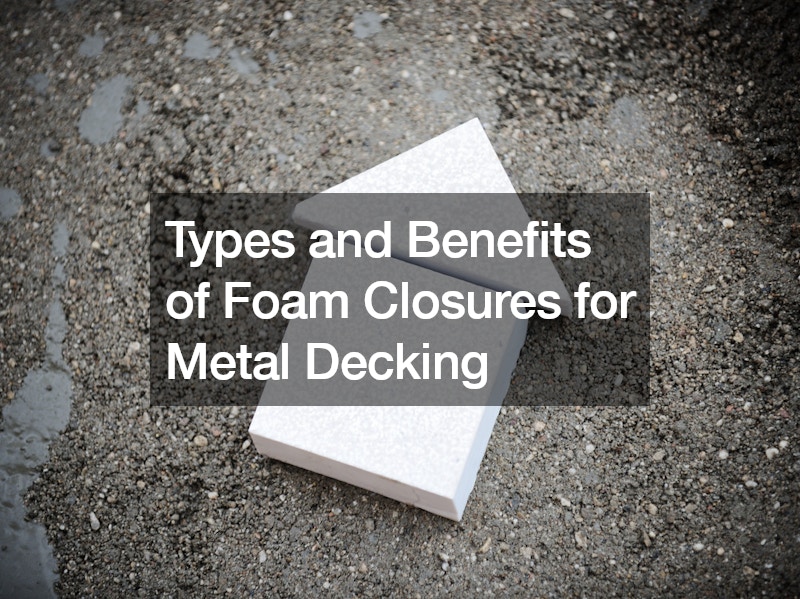
Metal decking is a popular choice for roofing and cladding in various construction projects due to its durability and strength. However, to ensure optimal performance and protection, proper installation techniques and accessories are crucial. Foam closures play a vital role in sealing gaps and providing various benefits for metal decking applications.
Introduction to Foam Closures
Foam closures are specialized sealing materials designed to fill the voids and gaps in metal decking systems. These closures come in different forms, including strips and individual plugs, and are typically made from durable foam materials.
Foam closures are installed at the ends of metal panels to provide a tight seal, preventing the ingress of moisture, pests, and debris while also minimizing light transmission and reducing noise.
Types of Foam Closures
Foam closures for metal decking are available in two primary types: those that fit outside the panel and those that fit inside the panel. The former, although less common, can be installed on the top surface of the panel to seal the gap between adjacent panels. However, the most prevalent type is the foam closure strip designed to fit inside the panel’s void.
Installation Process
Installing foam closures typically involves placing the closures at the ends of metal panels before securing them in place. Foam closure strips are installed by inserting them into the voids along the panel’s edges. Alternatively, individual foam closure plugs can be added after the metal decking is already installed, making the process more convenient and efficient.
It’s advisable to apply a bead of sealant along the top of the foam closure strips or plugs before installation to enhance adhesion and ensure a secure seal. This additional step helps prevent water infiltration and improves the overall effectiveness of the closures.
Benefits of Foam Closures
Foam closures offer several benefits for metal decking applications:
1. Minimizing Light: One of the primary advantages of foam closures is their ability to minimize the transmission of light through metal decking systems. By filling the voids between panels, foam closures create a seamless surface that reduces the visibility of light from the underside of the roof or cladding.
2. Pest Prevention: Foam closures act as barriers against pests such as birds, insects, and rodents. By sealing gaps and crevices, foam closures effectively deter pests from nesting or entering the building through the metal decking.
3. Moisture Resistance: While foam closures may not provide complete weatherproofing, they significantly reduce the risk of water infiltration from wind-blown rain and other sources. By sealing gaps and joints, foam closures help maintain the integrity of the roofing or cladding system and protect the underlying structure from moisture damage.
4. Noise Reduction: Foam closures contribute to noise reduction by filling gaps and minimizing vibrations in metal decking systems. This can be particularly beneficial in commercial and industrial settings where noise control is essential for occupant comfort and regulatory compliance.
5. Durability: Foam closures are durable and resilient, capable of withstanding exposure to environmental factors such as UV radiation, temperature fluctuations, and mechanical stress. High-quality foam materials ensure long-term performance and reliability in demanding conditions.
Maintenance and Inspection:
Routine maintenance and inspection are essential for ensuring the continued performance and longevity of foam closures for metal decking. Here are some key tips to keep in mind:
Regular Inspection: Schedule periodic inspections of the foam closures to check for signs of wear, damage, or deterioration. Pay attention to areas exposed to harsh weather conditions or mechanical stress, such as roof edges and corners.
Cleaning: Keep the foam closures clean and free from debris, dirt, or other contaminants that could compromise their effectiveness. Use gentle cleaning methods, such as wiping with a damp cloth or soft brush, to avoid damaging the closures.
Sealant Renewal: Monitor the condition of any sealant applied to the foam closures. If signs of deterioration or weathering are observed, consider reapplying sealant to maintain a watertight seal and prevent moisture infiltration.
Prompt Repairs: Address any issues or damage to the foam closures promptly. Repair or replace damaged closures as needed to prevent water leakage and ensure proper sealing of the metal roofing panels.
Professional Maintenance: Consider hiring a professional roofing contractor to conduct periodic maintenance inspections and repairs. Experienced professionals can identify potential issues early and implement effective solutions to prevent further damage.
By following these maintenance and inspection practices, you can extend the lifespan of foam closures for metal decking, minimize the risk of water infiltration, and preserve the integrity of your roofing system.
Conclusion
Foam closures are essential accessories for metal decking installations, offering a range of benefits that contribute to the overall performance and longevity of roofing and cladding systems. Whether used in strip or plug form, foam closures provide effective sealing, pest prevention, moisture resistance, noise reduction, and durability. By incorporating foam closures into metal decking projects, contractors and building owners can enhance the functionality, aesthetics, and longevity of their structures.
.

